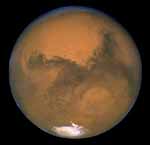Mercury - Latest Info
Jan. 14, 2008, the MESSENGER
spacecraft skimmed 200 kilometers (124 miles) above the surface of Mercury
in the first of three flybys of the planet. Initial indications from the
radio signals indicate the spacecraft is still operating nominally. The
first science data return from the flyby was received just minutes before
the closest approach point with the planet, as planned.
“The engineers and operators
at the Deep Space Network (DSN) in Goldstone, Calif., in conjunction with
engineers at the Johns Hopkins University Applied Physics Laboratory (APL)
in Laurel, Md., pulled off a tremendous feat, acquiring and locking onto
the downlink signal from the spacecraft within seconds, providing the necessary
Doppler measurements for the Radio Science team” said MESSENGER Mission
Systems Engineer Eric Finnegan, of APL.“ The spacecraft is continuing to
collect imagery and other scientific measurements from the planet as we
now depart Mercury from the illuminated side, documenting for the first
time the previously unseen surface of the planet.”
Tomorrow at noon EST,
the spacecraft will turn back towards the Earth to start down-linking the
on-board stored data. Measurements of this Doppler signal from the spacecraft
will allow improve knowledge of Mercury’s gravity field.Keeping a Rendezvous
with Mercury
Between January 9 and
13, 2008, as the MESSENGER probe approached Mercury for its first flyby,
the Narrow Angle Camera, part of the Mercury Dual Imaging System (MDIS),
acquired a series of images of the planet in support of spacecraft navigation.
These images have been put together as frames in a movie. The final frame
of the movie has the highest spatial resolution (20 km/pixel, 12 miles/pixel)
and was recorded when the spacecraft was at a distance of about 760,000
kilometers (470,000 miles) from Mercury. Mercury is about 4.880 kilometers
(about 3,030 miles) in diameter.
As part of MESSENGER's flyby
on January 14, MDIS will obtain high-resolution image sequences with the
Narrow Angle Camera, and the Wide Angle Camera will collect images in eleven
colors. The images will cover portions of the planet never before
seen by spacecraft, as well as regions that were photographed by Mariner
10 in 1974 and 1975. The new data for the previously studied areas
of Mercury will help scientists to interpret the data for the parts of
the planet that MESSENGER will reveal for the first time.
Additional information
and features from this first flyby can be viewed online at http://messenger.jhuapl.edu/mer_flyby1.html.
The latest released images and science results from the flyby will be posted
as they become available.
MESSENGER (MErcury Surface,
Space ENvironment, GEochemistry, and Ranging) is a NASA-sponsored scientific
investigation of the planet Mercury and the first space mission designed
to orbit the planet closest to the Sun. The MESSENGER spacecraft launched
on August 3, 2004, and after flybys of Earth, Venus, and Mercury will start
a yearlong study of its target planet in March 2011. Dr. Sean C. Solomon,
of the Carnegie Institution of Washington, leads the mission as principal
investigator. The Johns Hopkins University Applied Physics Laboratory built
and operates the MESSENGER spacecraft and manages this Discovery-class
mission for NASA. |
|



